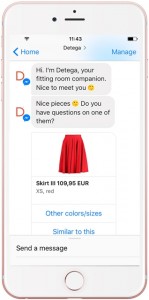Five key trends lie ahead in retail technology

Michael Goller of Detego
London-based Detego, a UK software company behind various Internet of Things (IoT) and artificial intelligence (AI) initiatives in fashion retail has unveiled five defining key trends that will earmark the retail technology scene in 2018 and beyond.
The company has experience that includes RFID-based merchandise management and digitally connected ‘smart fitting rooms’ capable of making recommendations to shoppers. It is confident that we will see further adoption of the IoT in everyday retail practices, plus rising investments in augmented reality and AI-powered chatbots that will change the way people shop and interact with stores in future, says Michael Goller, chief technology officer at Detego.
Trend # 1: Personalisation
The digital engagement of consumers, both online and in stores, facilitates the compilation of more and more information on customers, their behaviour, tastes and preferences. But making sense of all this data, coupled with the desire for increased levels of personalisation in retail, means there’ll be a greater dependency on analytical and self-learning systems in future.
Trend # 2: Chatbots
Interacting with customers and offering personalised services will bring AI powered chatbots onto the sales floor, meaning that consumers can get rapid assistance for general enquiries directly on their smartphone. In the not too distant future, it will be common practice to pull out your phone and ask a question as you enter a store, rather than seeking out a sales assistant or searching through the rails yourself.
For instance, the chatbot can immediately check with other systems in the background if a particular article is available in your size and notify the staff to bring it to you. These chatbots will bring a form of intelligence into the store that is well-known in online retailing, including targeted recommendations and offers, whilst promoting other popular, similar items, bestsellers, or articles on sale.
Trend # 3: Internet-of-Things (IoT)
Just as smart devices are being increasingly adopted in homes, so will IoT technology make more of a mark in retail. The use of sensors and tags on every item will mean that retailers can more accurately monitor the movement of goods and improve inventory management and achieve efficiencies rarely seen before.
Devices that communicate with each other in the store will also bring about a wealth of additional insights into consumer behaviour and preferences for particular product combinations, or flag ‘tried-on, but rarely bought’ articles. Consumers´ requests for more personalised offers will also be supported by the use of IoT in retail.
Trend # 4: Augmented reality
We’ve already started to see some retailers using augmented reality to engage customers emotionally and enrich their experience of a brand. Augmented reality combined with “location based” services is also making headway by, for instance, allowing retailers to push their locations onto the user´s smartphone using a 3D map; or helping customers find stores or particular items they are looking for in the right size and colour.
These technologies will support retailers to bridge the gap between e-commerce and bricks-and mortar retailing, offering consumers a seamless, more true-to-life experience across all channels.
Trend # 5: Open platforms
Retail IT landscapes of the future need to be as flexible as consumers are. To compete, retail companies must transition their IT systems to open platforms that enable rapid deployment of new solutions and make use of on-demand cloud services to create outstanding customer experiences. Open platforms will allow retailers to combine in-house software with third-party applications as well as to switch services on or off, as and when required.
This makes business innovation easier, faster and less expensive. Although open platforms aren’t yet the dominant force in retail IT landscapes, the increasing demand for greater flexibility will drive the industry to embrace “openness” as a way to meet the needs of evolving businesses and changing consumer requirements.
The author of this blog is Michael Goller, chief technology officer at Detego
Comment on this article below or via Twitter @IoTGN

